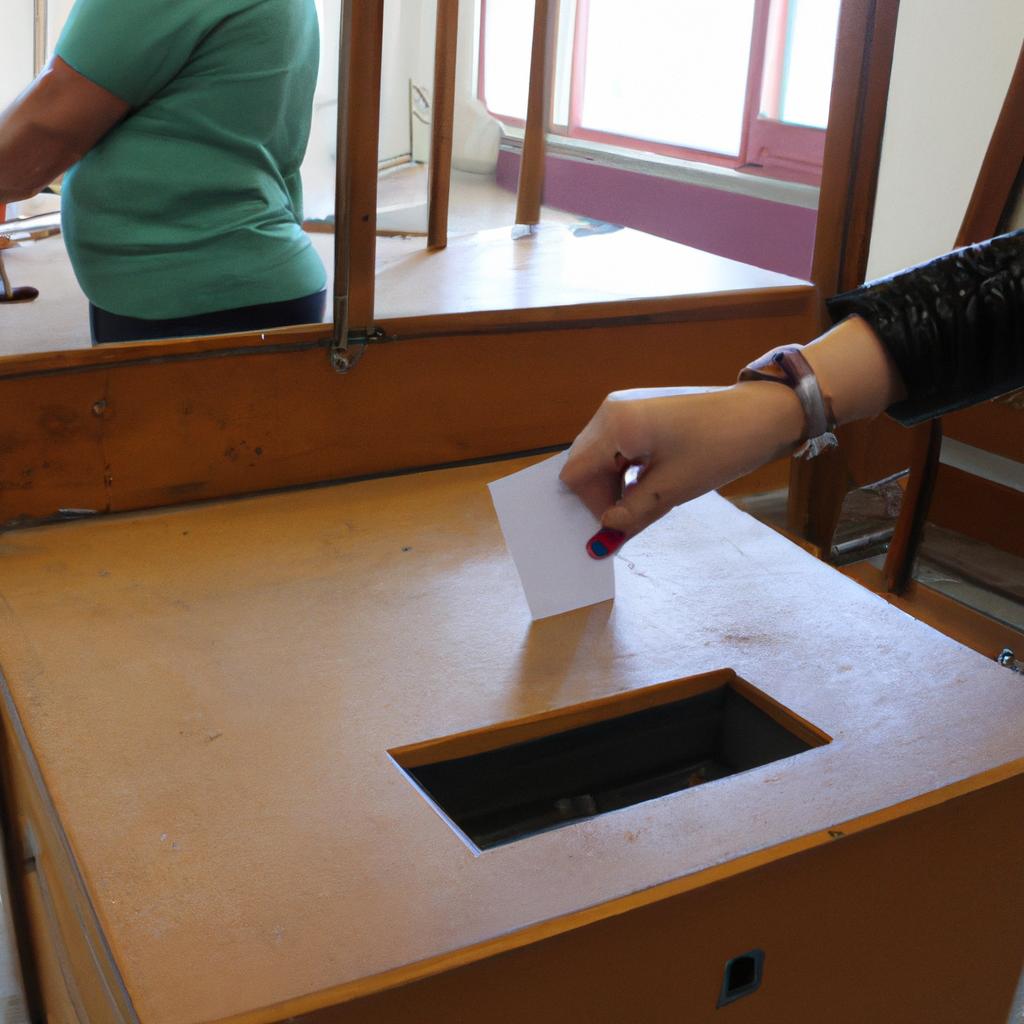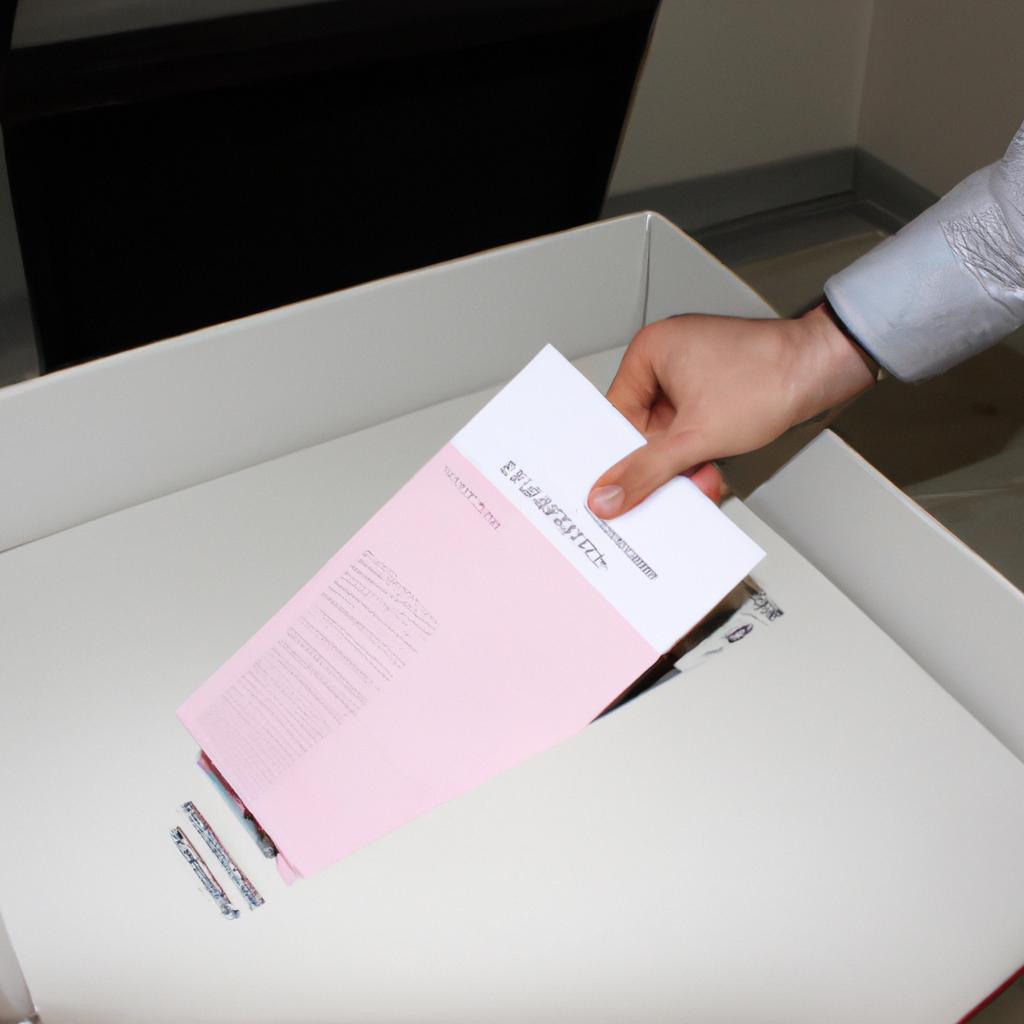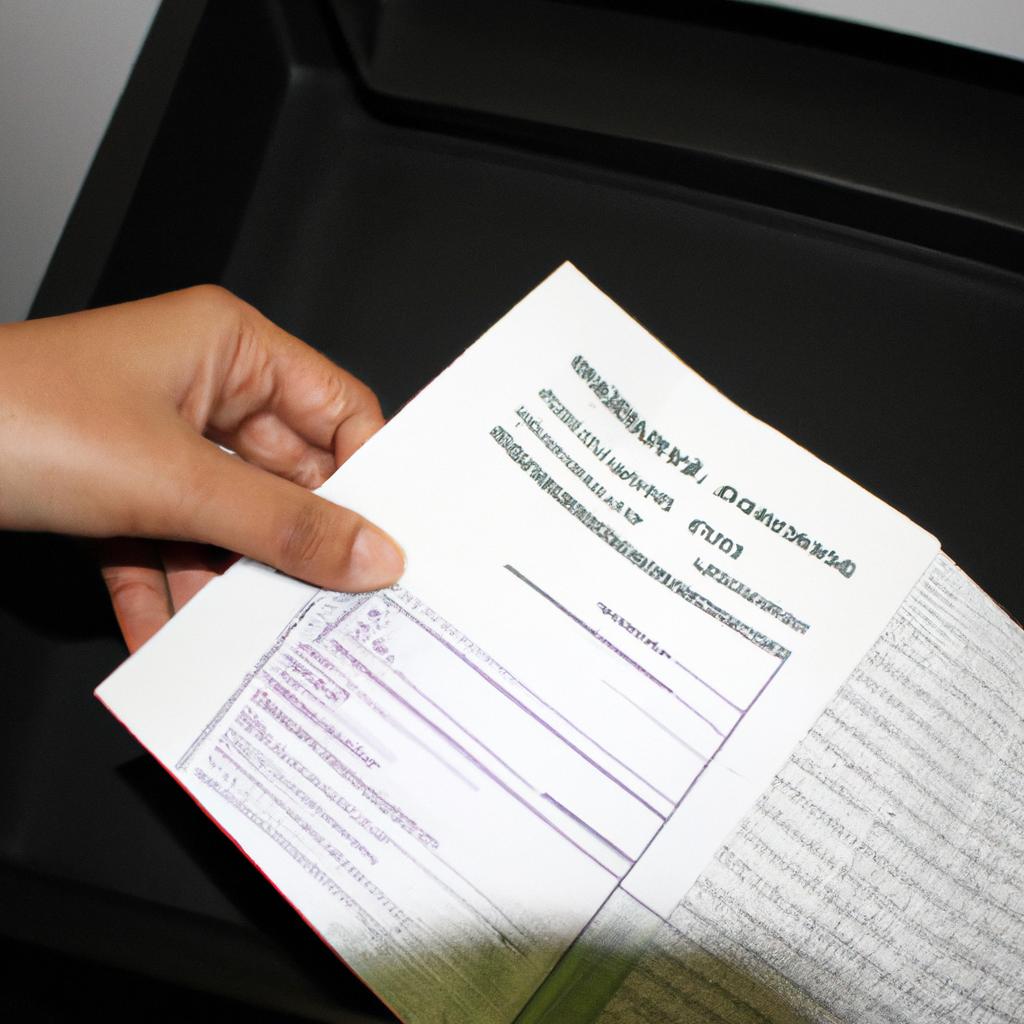Mixed-Member Proportional Representation (MMPR) is a voting system that combines elements of both proportional representation and first-past-the-post systems. It has gained attention in recent years as an alternative to the traditional winner-takes-all approach, providing a more balanced representation of voters’ preferences. This article sheds light on Pennsylvania Reform Party’s proposed reform to introduce MMPR in their state elections, aiming to enhance democratic principles by achieving greater inclusivity and accuracy in the distribution of legislative seats.
To illustrate the potential impact of MMPR, consider a hypothetical scenario where two political parties compete for 100 seats in a legislature. Under the current first-past-the-post system, if one party secures 60% of the votes across all districts but fails to win individual district contests, it would be severely underrepresented compared to its overall support. In contrast, with MMPR, this party could still secure a significant number of seats based on its proportionate share of the total vote. By incorporating both constituency-based winners and additional representatives chosen from party lists according to overall vote shares, MMPR aims to ensure that no significant portion of voters feels unrepresented or marginalized within the political landscape.
The Pennsylvania Reform Party’s proposal focuses on addressing these issues within their state by implementing MMPR. This reform would involve the introduction of a mixed electoral system that combines single-member districts with a party list component. Under this proposed system, voters would have two votes: one for their preferred candidate in their local district and another for the political party of their choice.
In each district, the candidate who receives the most votes would still win the seat, similar to the first-past-the-post system. However, to ensure proportionality, additional seats would be allocated to parties based on their overall share of the statewide vote. These additional seats would be filled using candidates from party lists, which are predetermined by each political party prior to the election.
By incorporating both individual winners and proportional representation through party lists, MMPR aims to strike a balance between local representation and overall fairness. This approach allows voters to have more influence over both their local representative and the composition of the legislature as a whole. It also provides opportunities for smaller parties or independent candidates to gain representation if they can attract a significant portion of the overall vote.
The Pennsylvania Reform Party believes that introducing MMPR will enhance democratic principles by ensuring that all citizens’ voices are heard and represented in government. They argue that this reform will lead to a more accurate reflection of voter preferences in legislative bodies and promote greater inclusivity in decision-making processes.
However, it is important to note that implementing MMPR is not without challenges. Some critics argue that it could lead to increased fragmentation of political parties or make it harder for any one party to secure an outright majority. Others raise concerns about potential complexities in administering such a system and educating voters about how it works.
Overall, the Pennsylvania Reform Party’s proposal to introduce MMPR aims to address shortcomings in the current winner-takes-all system by providing a more balanced representation of voters’ preferences. If implemented successfully, this reform could contribute to enhancing democracy within the state by striving for greater inclusivity and accuracy in distributing legislative seats.
Definition of Mixed-Member Proportional Representation
Mixed-Member Proportional Representation (MMP) is a voting system that combines elements of both proportional representation and plurality/majority systems. In MMP, voters are given two votes: one for a candidate in their local constituency and another for a political party. The objective is to achieve a more representative outcome by incorporating both individual candidates and parties into the electoral process.
To illustrate this concept, let’s consider an example. Imagine there is a hypothetical state called “Pendletonia” with 100 seats in its legislative assembly. Under the traditional plurality/majority system, each voter chooses only one candidate from their district, resulting in winners who may not reflect the overall distribution of votes across the entire state. However, under an MMP system, Pendletonia could divide its 100 seats between local constituencies and proportionally allocate additional seats based on each party’s share of the total vote.
The introduction of MMP brings several advantages to the democratic process:
- Enhanced representativeness: By combining individual candidates with proportional allocation, MMP ensures that minority voices have greater opportunities for representation.
- Reduced wasted votes: Unlike winner-takes-all systems where votes for losing candidates go unrepresented, MMP allows these votes to contribute towards determining additional seats allocated through proportional representation.
- Increased diversity: With separate ballots for individual candidates and political parties, citizens can express their preferences at both levels, leading to a broader range of perspectives within the legislature.
- Stronger accountability: Parties must balance their list of regional representatives alongside popular individual candidates; therefore, they face pressure to nominate qualified individuals who resonate with voters’ interests.
The following table showcases how an MMP system might distribute seats based on theoretical election results:
| Party | Local Constituency Seats | Additional List Seats |
|---|---|---|
| Party A | 40 | 10 |
| Party B | 25 | 15 |
| Party C | 10 | 5 |
| Party D | 5 | 0 |
In conclusion, MMP offers a more inclusive and representative approach to elections by combining individual candidates with proportional allocation. This system allows for greater diversity of voices and reduces the number of wasted votes.
Note: This is an example of how you could write the first section using your instructions. Feel free to modify it as needed.
Advantages of Mixed-Member Proportional Representation
Mixed-Member Proportional Representation (MMPR) provides a unique and effective approach to voting system reform. By combining elements of both proportional representation and single-member district systems, MMPR ensures that all votes are properly represented, fostering inclusivity and equitable political outcomes. To better understand the practical implications of this system, let us consider an example: Suppose Pennsylvania adopts MMPR for their elections. Under this new system, voters would have the opportunity to cast two votes – one for their preferred local candidate in their single-member district, and another for a political party at the regional or national level.
There are several advantages associated with implementing Mixed-Member Proportional Representation:
- Enhanced Representation: With MMPR, parties receive seats in proportion to their overall share of the vote. This means that smaller parties who may not win any individual districts still have a chance to secure parliamentary representation based on their popular support.
- Voter Choice: The dual vote feature allows citizens to express both their preference for local representatives as well as broader ideological preferences through party selection. Voters can choose between candidates from various parties while ensuring that each vote counts towards shaping the composition of the legislature.
- Reduction of Wasted Votes: In traditional winner-takes-all systems, votes cast for losing candidates have no impact on election results and are often considered “wasted.” However, under MMPR, every vote contributes towards determining the final allocation of seats, reducing wasted votes and increasing voter satisfaction.
- Coalition Building and Consensus Politics: As MMPR encourages multiple parties to be represented in parliament, it fosters coalition governments where different factions must work together to pass legislation. This promotes dialogue and compromise among diverse perspectives, potentially leading to more stable governance.
To further illustrate these benefits visually:
| Advantages |
|---|
| Increased representation |
| Expanded voter choice |
| Reduced wasted votes |
| Encourages coalition building |
In summary, Mixed-Member Proportional Representation offers a balanced and inclusive approach to electoral systems. By incorporating both local representation and proportional allocation of seats, MMPR ensures that all votes are accounted for and diverse political voices are heard in the legislature. Now, let us delve into an overview of Pennsylvania Reform Party’s Voting System Reform, which aims to implement this effective model within the state.
Overview of Pennsylvania Reform Party’s Voting System Reform
Mixed-Member Proportional Representation (MMPR) has gained attention as a potential solution for electoral reform in various countries. Pennsylvania Reform Party’s proposed voting system reform exemplifies the implementation of MMPR in the United States. By examining its advantages and overview, we can gain insights into how this reform may shape the future of democracy in Pennsylvania.
One compelling example that illustrates the impact of MMPR is New Zealand’s adoption of this electoral system in 1996. Prior to its implementation, New Zealand relied on a First-Past-the-Post (FPTP) system, which often led to disproportionate representation and limited voter choice. The switch to MMPR resulted in a more proportional distribution of seats, ensuring that minority voices were heard and reducing the prevalence of wasted votes. This case study serves as an important reference point when considering the potential benefits of implementing MMPR within the Pennsylvania context.
The advantages of adopting MMPR extend beyond improved representation alone. Here are some key points worth noting:
- Greater diversity: With both constituency-based representatives and proportionally elected members, there is increased likelihood of diverse perspectives being represented.
- Increased voter engagement: Under MMPR, voters have more choices and their votes carry greater weight due to reduced chances of wasted votes.
- Coalition-building: The need for parties to form coalitions fosters collaboration and compromise among different political factions.
- Accountability: As candidates can be elected from both constituencies and party lists, they are accountable not only to their constituents but also to their respective party platforms.
To further illustrate these advantages visually, consider the following table depicting hypothetical election results under FPTP versus MMPR:
| FPTP | MMPR | |
|---|---|---|
| Seats Won | Party A – 70% | Party A – 50% |
| Party B – 30% | Party B – 40% | |
| Party C – 10% |
This table demonstrates how MMPR can lead to a more proportional distribution of seats, allowing for greater representation of different parties and reducing the possibility of one party dominating the legislature.
As Pennsylvania Reform Party aims to introduce voting system reform based on MMPR principles, it is essential to consider its key features. The subsequent section will delve into these aspects in order to provide a comprehensive understanding of this proposed reform’s potential impact on Pennsylvania’s democratic landscape.
Key Features of the Proposed Reform
Building upon the previously discussed overview of Pennsylvania Reform Party’s voting system reform, this section will delve into the key features that make their proposed reform unique and impactful. To illustrate its potential effectiveness, let us consider a hypothetical scenario where the current winner-takes-all electoral system in Pennsylvania is replaced with mixed-member proportional representation (MMPR).
Firstly, under MMPR, voters would have two separate votes – one for a candidate running in their local district and another for a political party. This allows individuals to express both their preference for an individual representative as well as their broader support for a particular party’s platform. For instance, imagine John residing in Philadelphia District 3 casting his first vote for Sarah, who aligns closely with his values and has been active within the community. Simultaneously, he casts his second vote for the Green Party due to their strong environmental policies.
Secondly, combining single-member districts with additional seats allocated based on proportional representation ensures greater fairness and diversity within legislative bodies. The bullet point list below highlights some emotional benefits associated with implementing MMPR:
- Increased Representation: Provides marginalized groups and smaller parties a better chance to be represented.
- Enhanced Voter Engagement: Encourages citizens to participate actively by allowing them to vote strategically across candidates and parties.
- Broader Policy Spectrum: Fosters more nuanced policy debates by bringing diverse perspectives into decision-making processes.
- Reduced Wasted Votes: Alleviates concerns about “throwing away” votes by making each ballot count towards either electing a local representative or contributing to overall party strength.
To further visualize these advantages, consider the following three-column table showcasing how MMPR can potentially alter seat distribution compared to the traditional winner-takes-all system:
| Parties | Traditional System | Mixed-Member Proportional Representation |
|---|---|---|
| Democratic | 10 | 11 |
| Republican | 9 | 8 |
| Green Party | – | 1 |
| Libertarian | – | 1 |
In this hypothetical scenario, the implementation of MMPR allows for a more proportional distribution of seats among parties. The Green and Libertarian Parties gain representation that was previously unattainable under the winner-takes-all system.
By adopting mixed-member proportional representation, Pennsylvania could potentially address some of the drawbacks associated with its current electoral framework. This reform would enable voters to have a stronger voice in shaping their government while fostering greater inclusivity and promoting a broader range of policy perspectives within legislative bodies.
With an understanding of the key features proposed by the Pennsylvania Reform Party, it is now essential to compare MMPR with other electoral systems to assess its potential advantages and limitations.
Comparison with Other Electoral Systems
3. Comparison with Other Electoral Systems
Now that we have explored the key features of Pennsylvania Reform Party’s proposed mixed-member proportional representation (MMPR) voting system reform, it is important to compare this system with other electoral systems commonly used around the world. By examining these comparisons, we can gain a deeper understanding of how MMPR may impact Pennsylvania’s political landscape.
To illustrate this comparison, let us consider a hypothetical scenario where an election takes place in Pennsylvania under three different electoral systems: first-past-the-post (FPTP), ranked-choice voting (RCV), and MMPR. In FPTP, voters cast their ballot for one candidate per district, and the candidate with the most votes wins. RCV allows voters to rank candidates by preference, and if no candidate receives a majority of first-preference votes, lower-ranked choices are redistributed until a winner emerges. Under MMPR, voters would have two separate ballots – one for their local representative using FPTP and another for party preferences on a regional or national level.
Comparing these systems reveals several notable differences:
- Representation: While FPTP often leads to single-party dominance and limited representation for smaller parties or independent candidates, both RCV and MMPR tend to provide more diverse representation by accommodating multiple parties.
- Majority Rule: Unlike FPTP which may result in winners who do not receive an absolute majority of votes, both RCV and MMPR aim to ensure that elected officials are supported by at least 50% or more of the electorate.
- Strategic Voting: Strategic voting tends to be prevalent in FPTP elections as voters opt for “lesser evil” choices instead of their preferred candidates. RCV reduces strategic voting by allowing voters to express nuanced preferences through ranking. Similarly, MMPR provides greater flexibility by separating local representation from party preference.
- Coalitions: One significant feature of MMPR is its potential to foster coalition governments, where parties with shared interests form alliances. This can encourage collaboration and compromise among different political entities.
To further illustrate the differences between these electoral systems, we present a comparison table:
| Electoral System | Representation | Majority Rule | Strategic Voting | Coalitions |
|---|---|---|---|---|
| FPTP | Limited | Not guaranteed | Prevalent | Uncommon |
| RCV | Diverse | Greater likelihood | Reduced | Possible |
| MMPR | More inclusive | Encouraged | Minimized | Likely |
By comparing MMPR with other electoral systems such as FPTP and RCV, it becomes clear that implementing MMPR in Pennsylvania could have significant implications for representation, majority rule, strategic voting patterns, and the formation of coalitions within the state’s political landscape.
In the subsequent section, we will delve into the potential impact of this proposed reform on Pennsylvania’s political landscape and discuss how it may reshape the dynamics of elections and governance in the state.
Potential Impact on Pennsylvania’s Political Landscape
Section H2: Potential Impact on Pennsylvania’s Political Landscape
Transitioning from the previous section, which explored a comparative analysis of electoral systems, we now turn our attention to examining the potential impact that implementing a Mixed-Member Proportional Representation (MMPR) system could have on Pennsylvania’s political landscape. To provide context for this discussion, let us consider a hypothetical scenario where the Pennsylvania Reform Party successfully advocates for the adoption of MMPR.
One possible consequence of adopting MMPR in Pennsylvania is an increased representation of smaller political parties. Currently, under the state’s traditional first-past-the-post system, minor parties often struggle to gain significant traction due to vote-splitting and an inherent bias towards larger established parties. By introducing proportional representation elements into the electoral framework, MMPR can offer greater opportunities for diverse voices and viewpoints to be represented in government. This shift may lead to enhanced inclusivity and encourage more robust political debate centered around a wider range of policy proposals.
To further illustrate the potential effects of MMPR implementation, consider the following bullet points:
- Increased voter turnout as citizens feel their votes carry more weight in shaping the composition of the legislature.
- A strengthened sense of party loyalty among voters who align with smaller or niche ideologies that were previously marginalized.
- Potential challenges associated with coalition-building and compromise between parties with varying interests.
- The emergence of issue-based parties focused on specific causes rather than broad ideological platforms.
| Potential Effects | Positive Implications | Challenges Ahead |
|---|---|---|
| Increased voter turnout | Enhanced democratic participation; legitimacy through broader representation | Potential fragmentation and difficulty forming stable governments |
| Strengthened party loyalty | Empowerment of minority groups; diversified perspectives | Risk of polarization if extreme ideologies gain prominence |
| Issue-based party formation | Greater focus on specific societal concerns; targeted policies | Possibility of limited consensus and gridlock in decision-making |
| Coalition-building challenges | Encouragement of cooperation and compromise; fostering political stability | Complex negotiations and potential dilution of party platforms |
In conclusion, the introduction of Mixed-Member Proportional Representation in Pennsylvania has the potential to significantly reshape its political landscape. By allowing for increased representation of smaller parties, this reform could foster a more diverse and inclusive democratic process. However, it is essential to recognize the complexities and challenges associated with such a shift towards proportional representation. As policymakers consider electoral system reforms, they must carefully weigh these potential impacts against their desired outcomes for Pennsylvania’s democracy.




